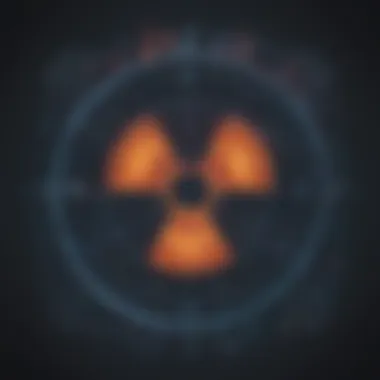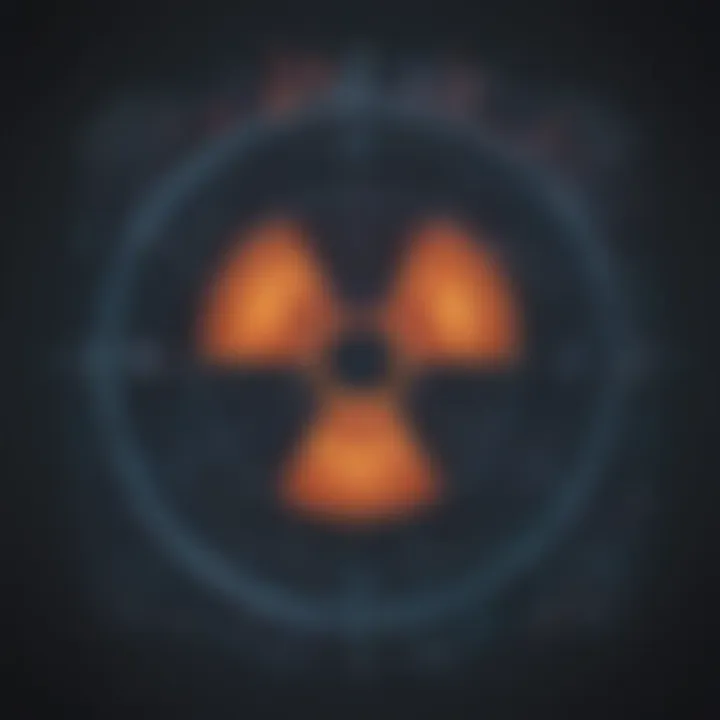Unveiling the Detrimental Impacts of Nuclear Technology: A Comprehensive Analysis of the Downsides


Technology Insights
Nuclear technology, despite its advancements, harbors an array of drawbacks. Delving into the realm of nuclear power unveils a concerning narrative surrounding environmental impact and safety precariousness. The innovative strides in the nuclear field starkly contrast with the consequential dangers they pose. This section aims to dissect the adverse facets of nuclear technology, shedding light on its darker implications.
Environmental Concerns
One of the primary downsides of nuclear technology revolves around its environmental ramifications. The extraction, processing, and transportation of nuclear materials leave a significant carbon footprint, contributing to global warming and environmental degradation. The disposal of radioactive waste further exacerbates these issues, posing long-term risks to ecosystems and human health. Understanding the environmental perils of nuclear power is crucial in fostering sustainable energy practices and mitigating ecological harm.
Safety Risks
Another critical aspect to consider is the inherent safety risks associated with nuclear technology. Accidents such as Chernobyl and Fukushima serve as stark reminders of the catastrophic consequences of nuclear mishaps. The potential for reactor meltdowns, radioactive leaks, and nuclear proliferation underscores the gravity of nuclear safety concerns. Exploring these risks in depth illuminates the need for stringent safety protocols, regulatory oversight, and risk mitigation strategies within the nuclear industry.
Introduction
In delving into the complexities of nuclear technology, it is imperative to unravel its downside comprehensively. This exploration shines a crucial light on aspects often overshadowed by the allure of nuclear power's benefits. While nuclear technology offers immense potential in energy production, medical applications, and scientific research, the negative implications cannot be ignored. Understanding the dark underbelly of nuclear technology is vital for making informed decisions and fostering responsible usage.
Nuclear power plants, despite their clean energy output, pose significant challenges in terms of radioactive waste disposal, safety concerns, economic burdens, security risks, and public perceptions. The environmental impact of nuclear technology extends to the long-term storage of radioactive waste, which presents intricate issues and risks to ecosystems. Additionally, nuclear facilities contribute to water pollution through eutrophication and thermal pollution, degrading aquatic environments and posing threats to biodiversity.
Safety remains a paramount concern in the nuclear power industry, highlighted by catastrophic events like the Chernobyl disaster and the Fukushima Daiichi incident. Accidents and malfunctions can have far-reaching consequences, affecting human health through increased cancer risks and genetic mutations. The economic considerations surrounding nuclear technology involve high construction and decommissioning costs, often burdening taxpayers and distorting market dynamics through subsidies and government support.
Security risks associated with nuclear technology encompass the looming threats of terrorism, nuclear proliferation, and vulnerabilities in safeguarding nuclear materials. The potential for illicit trafficking and the perpetuation of a nuclear arms race further compound these security challenges. Public perceptions of nuclear technology are colored by a lack of trust, driven by media portrayals, community resistance, cultural opposition, and ethical concerns.
In concluding this exploration of the downsides of nuclear technology, it becomes evident that a nuanced understanding of its ramifications is essential. By shedding light on the under-discussed aspects of nuclear power, we pave the way for informed dialogue and decision-making regarding the future of this powerful yet double-edged technological marvel.
Environmental Impact
Exploring the environmental impact of nuclear technology is crucial in shedding light on the negative consequences it brings. The radioactive waste produced poses significant challenges in terms of disposal, with long-term storage being a major concern. Issues related to the safe containment of radioactive materials highlight the complexity and risks involved. The impact on ecosystems due to nuclear activities further exacerbates environmental damage. The discharge of heated water into water bodies leads to thermal pollution, affecting aquatic life. Additionally, eutrophication caused by nutrient-rich effluents results in ecological imbalances in aquatic environments.
Radioactive Waste Disposal
Issues with Long-Term Storage


Delving into the specifics of long-term storage issues associated with radioactive waste disposal reveals the intricate nature of safely managing such hazardous materials. The challenges of ensuring the containment and isolation of radioactive waste over extended periods present significant hurdles. The need for secure and reliable storage facilities that can withstand the test of time is paramount. Balancing the risks of potential leaks or exposures with the long-term integrity of storage solutions is a delicate task. Despite the advancements in storage technologies, ensuring foolproof protection against environmental contamination remains a primary concern.
Impact on Ecosystems
The impact of radioactive waste on ecosystems is profound, with ecosystem health being jeopardized by nuclear activities. The contaminating effect of radioactive materials on fauna and flora raises pressing environmental conservation issues. The disruption of food chains and biodiversity due to exposure to radiation poses long-term challenges. Mitigating the ecological repercussions of nuclear waste requires comprehensive strategies to safeguard aquatic and terrestrial ecosystems. Implementing measures to reduce the spread of radioactive contaminants and restore affected habitats is essential in preserving environmental balance.
Water Pollution
Exploring the water pollution caused by nuclear activities unravels the detrimental effects on aquatic environments. Eutrophication resulting from nutrient overload in water bodies leads to algae overgrowth and oxygen depletion. The disruption of aquatic ecosystems due to eutrophication highlights the far-reaching consequences of nuclear-related water pollution. Additionally, thermal pollution from the release of heated water into rivers or lakes impacts aquatic life by altering water temperatures. The thermal stress induced by elevated water temperatures negatively affects aquatic organisms, especially sensitive species. Balancing the need for effective cooling systems in nuclear facilities with minimizing thermal pollution is a critical consideration to mitigate water pollution impacts.
Safety Concerns
In delving into the discussion on the downsides of nuclear technology, one pivotal aspect that demands scrutiny is safety concerns. Understanding the safety risks associated with nuclear power is crucial for comprehending the extensive implications of utilizing this technology. Safety considerations encompass various elements that have a direct impact on human health, environmental well-being, and the overall stability of nuclear facilities. It is imperative to recognize the significance of prioritizing safety protocols and measures in nuclear power operations to mitigate potential risks and catastrophic events.
Risk of Accidents
Chernobyl Disaster
The Chernobyl Disaster stands out as a defining moment in the history of nuclear power mishaps. This catastrophic incident unfolded due to a combination of human error, inadequate safety measures, and technological failures, resulting in a massive release of radioactive contaminants. The key characteristic of the Chernobyl Disaster lies in its scale of devastation and long-lasting consequences on both human populations and the environment. This event serves as a sobering example of the catastrophic potential inherent in nuclear technology, highlighting the pressing need for stringent safety regulations and prudent operational practices in nuclear facilities.
Fukushima Daiichi Incident
The Fukushima Daiichi Incident brought to light the vulnerability of nuclear power plants to natural disasters, particularly in seismically active regions. This incident, triggered by a powerful earthquake and subsequent tsunami, led to multiple meltdowns and the release of radioactive materials into the environment. The key characteristic of the Fukushima Daiichi Incident underscores the intersection of natural calamities with the intricate systems of nuclear power generation, emphasizing the complex challenges in ensuring the safety and integrity of nuclear facilities. Analyzing the Fukushima Daiichi Incident sheds light on the dynamic nature of safety concerns in nuclear technology and underscores the importance of robust disaster preparedness and response strategies.
Health Impacts
Exploring the health impacts associated with nuclear technology reveals intricate interplays between radiation exposure and human well-being. Cancer risks loom large as a significant health repercussion of prolonged exposure to ionizing radiation. The key characteristic of cancer risks stemming from nuclear technology lies in the heightened probability of developing various malignancies due to cellular changes induced by radiation. Understanding the mechanisms behind cancer development in the context of nuclear exposure is essential for formulating comprehensive health policies and monitoring programs to safeguard public health.
Genetic mutations represent another concerning health impact linked to nuclear technology. The unique feature of genetic mutations induced by radiation exposure lies in the heritable changes to DNA structure, potentially affecting future generations. Delving deeper into the study of genetic mutations resulting from nuclear radiation underscores the complex intergenerational implications of nuclear accidents and emissions. Recognizing the far-reaching consequences of genetic mutations underscores the critical importance of stringent safety measures and regulatory oversight in nuclear technology to avert adverse health outcomes and genetic disruptions.
Economic Considerations


Economic considerations play a pivotal role in understanding the drawbacks of nuclear technology. In the realm of nuclear power, financial aspects can significantly impact decision-making processes and long-term sustainability. One of the key elements under economic considerations is the assessment of high costs associated with nuclear technology. These costs encompass various components, such as construction expenses and decommissioning costs, which are crucial in evaluating the overall viability of nuclear power plants. Analyzing these economic factors provides insights into the feasibility and challenges of nuclear energy adoption.
High Costs
Construction Expenses
Construction expenses constitute a substantial part of the economic considerations linked to nuclear technology. These expenses cover the initial outlay required to build and set up nuclear power facilities. They encompass a range of activities, including site preparation, engineering, procurement, construction, and commissioning. The intricacies of construction expenses lie in their intricate cost allocation models, rigorous project management techniques, and adherence to stringent safety standards. While high initial investments are necessary to establish nuclear power plants, the durability and efficiency of these structures contribute to their appeal as long-term energy solutions.
Decommissioning Costs
Decommissioning costs refer to the expenses involved in dismantling and deconstructing nuclear facilities at the end of their operational lifespan. This phase requires meticulous planning, specialized equipment, and skilled labor to ensure the safe closure of nuclear sites and the management of radioactive materials. Decommissioning costs are influenced by factors such as the reactor type, facility size, regulatory requirements, and waste disposal procedures. Despite the financial burden of decommissioning, ensuring proper decommissioning is essential for mitigating environmental risks and safeguarding public safety.
Subsidies and Government Support
Government subsidies and support mechanisms play a significant role in the economic landscape of nuclear technology. Subsidies can offset some of the high costs associated with nuclear power projects, making them more economically viable and attractive for investors. However, subsidies also raise concerns about market distortions and resource allocation inefficiencies. The impact of taxpayer funding on nuclear initiatives is a subject of debate, as it involves balancing the societal benefits of nuclear energy against the direct costs borne by taxpayers. Market distortions resulting from government interventions can affect the competitiveness of alternative energy sources and impede technological innovation in the energy sector.
Impact on Taxpayers
The impact of nuclear subsidies on taxpayers is a critical aspect of economic considerations. Taxpayer funds are often channeled into nuclear projects to support research, construction, and operational activities. The allocation of taxpayer money towards nuclear initiatives raises questions about transparency, accountability, and the distribution of public resources. Evaluating the cost-benefit ratio of nuclear investments provides valuable insights into the socioeconomic implications for taxpayers and the broader community.
Market Distortions
Market distortions caused by government support for nuclear power can disrupt the natural balance of the energy market. Subsidies and incentives may artificially inflate the competitiveness of nuclear energy, disadvantaging other renewable energy sources. This could lead to market inefficiencies, reduced innovation in clean energy technologies, and skewed investment patterns. Regulating market distortions in the energy sector requires a nuanced approach that considers both the economic benefits and repercussions of government interventions.
Security Risks
Security risks associated with nuclear technology play a crucial role in understanding the potential drawbacks of this energy source. In a world where threats come in various forms, it is imperative to grasp the implications of security vulnerabilities in nuclear facilities. These risks extend beyond physical safety concerns to encompass potential terrorist activities and the proliferation of weapons of mass destruction. By exploring the intricate landscape of security risks, we can mitigate the likelihood of catastrophic events and bolster global security measures.
Terrorism Threats
Risk of Nuclear Proliferation


The risk of nuclear proliferation stands out as a significant aspect of security risks linked to nuclear technology. This proliferation presents a pressing challenge as it involves the spread of nuclear weapons or technology to nations or non-state actors without proper authorization. The inherent danger lies in the destabilization of global security frameworks and the escalation of international tensions. Understanding the complexities of nuclear proliferation is paramount in addressing the broader security landscape and fortifying non-proliferation efforts worldwide.
Security Vulnerabilities
Security vulnerabilities represent another critical facet within the realm of nuclear security risks. These vulnerabilities encompass weaknesses in infrastructure, protocols, or personnel that could potentially be exploited by malicious entities. Such vulnerabilities serve as entry points for illicit activities, endangering not only the facilities themselves but also the surrounding population and environment. By addressing and rectifying these vulnerabilities, we can enhance the resilience of nuclear facilities and bolster their defenses against external threats, thereby safeguarding against potential disasters.
Weapons Proliferation
Nuclear Arms Race
The nuclear arms race signifies a pivotal aspect concerning the proliferation of nuclear weapons among nations. This relentless competition for nuclear supremacy underscores the volatile nature of international relations and fuels a cycle of militarization. The proliferation of nuclear arms not only heightens tensions between states but also poses a grave threat to global peace and stability. Delving into the intricacies of the nuclear arms race sheds light on the escalating risks associated with nuclear proliferation and underscores the urgent need for disarmament initiatives.
Illicit Trafficking
Illicit trafficking of nuclear materials constitutes a grave concern in the realm of nuclear weapons proliferation. This illicit trade involves the unauthorized movement of nuclear components or technologies across borders, presenting a clear and present danger to global security. The clandestine nature of illicit trafficking makes it challenging to detect and thwart, amplifying the risks associated with nuclear proliferation. Addressing this issue calls for robust international cooperation, stringent enforcement mechanisms, and comprehensive monitoring to curb the illicit transfer of nuclear materials and prevent potential misuse.
Public Perceptions
In discussing the downsides of nuclear technology, the aspect of public perceptions holds significant importance. Understanding how the public views and interacts with nuclear power is crucial in assessing its overall impact. Public perceptions are shaped by a variety of factors, including media portrayals and community resistance, influencing societal attitudes and decisions regarding nuclear technology. By analyzing the public's trust and acceptance of nuclear power, a more comprehensive understanding of the challenges and concerns surrounding this technology can be achieved.
Lack of Public Trust
The lack of public trust in nuclear technology is a key issue that deserves careful consideration. Media portrayals play a pivotal role in shaping public perceptions of nuclear power. The depiction of nuclear incidents, such as the Chernobyl Disaster and the Fukushima Daiichi Incident, often leads to increased public unease and skepticism. Media portrayals tend to highlight the catastrophic consequences of nuclear accidents, emphasizing the potential risks and dangers associated with nuclear energy. While this heightened awareness can promote safety measures and accountability, it can also contribute to fear and mistrust among the public, hindering informed decision-making regarding nuclear technology.
Community Resistance
Community resistance towards nuclear technology further underscores the complex issue of public trust. Residents living near nuclear facilities or proposed nuclear power plants often express concerns about safety, environmental impact, and long-term consequences. Community resistance can manifest in various forms, including protests, legal challenges, and grassroots movements advocating for stringent regulations or alternative energy sources. This opposition stems from a desire to protect communities from potential harm and to hold industry and governmental bodies accountable for transparent communication and risk mitigation. While community resistance serves as a check on unchecked nuclear development, it also adds layers of complexity to the public discourse surrounding nuclear energy, highlighting the need for constructive dialogue and engagement between stakeholders.
Social Acceptance
The aspect of social acceptance plays a crucial role in shaping the trajectory of nuclear technology. Cultural opposition to nuclear power reflects deep-seated beliefs, values, and traditions embedded within societies. Cultural factors influence public perceptions of nuclear technology, framing discussions in terms of morality, heritage, and national identity. Ethical concerns regarding the use of nuclear energy further contribute to the social debate surrounding its adoption and expansion. Questions of intergenerational equity, environmental justice, and technological responsibility shape how communities and policymakers navigate the complexities of integrating nuclear power into the energy landscape. By examining the nuanced interplay between cultural opposition and ethical considerations, a holistic view of the social acceptance of nuclear technology emerges, shedding light on the multifaceted dimensions of public engagement with this controversial yet essential energy source.
Conclusion
Nuclear technology has long been a subject of controversy, fraught with debates and deliberations. As we reach the culmination of this exploration into the downsides of nuclear technology, it becomes evident that the topic of conclusion holds paramount importance in this exhaustive narrative. By delving into the multiple facets of nuclear power - ranging from safety concerns to environmental impacts, economic considerations to security risks, public perceptions to health effects - it becomes clear that a nuanced understanding of the drawbacks is imperative in shaping informed decisions and policies regarding nuclear technology.
The significance of the conclusion lies in synthesizing the vast array of information and insights provided throughout the article. It serves as a pivotal moment where readers are encouraged to reflect on the holistic implications of nuclear technology on society, the environment, and global dynamics. By encapsulating the key points discussed in each preceding section, the conclusion provides a cohesive outlook on the complexities and challenges associated with nuclear power.
Furthermore, the conclusion serves as a call to action, prompting stakeholders, policymakers, and the public to critically evaluate the trade-offs involved in harnessing nuclear energy. It underscores the need for ongoing dialogues, research, and innovation to mitigate the negative consequences highlighted in this comprehensive exploration. Ultimately, the conclusion acts as a bridge between knowledge and action, urging proactive approaches towards addressing the cons of nuclear technology while striving for a sustainable and secure energy landscape.







